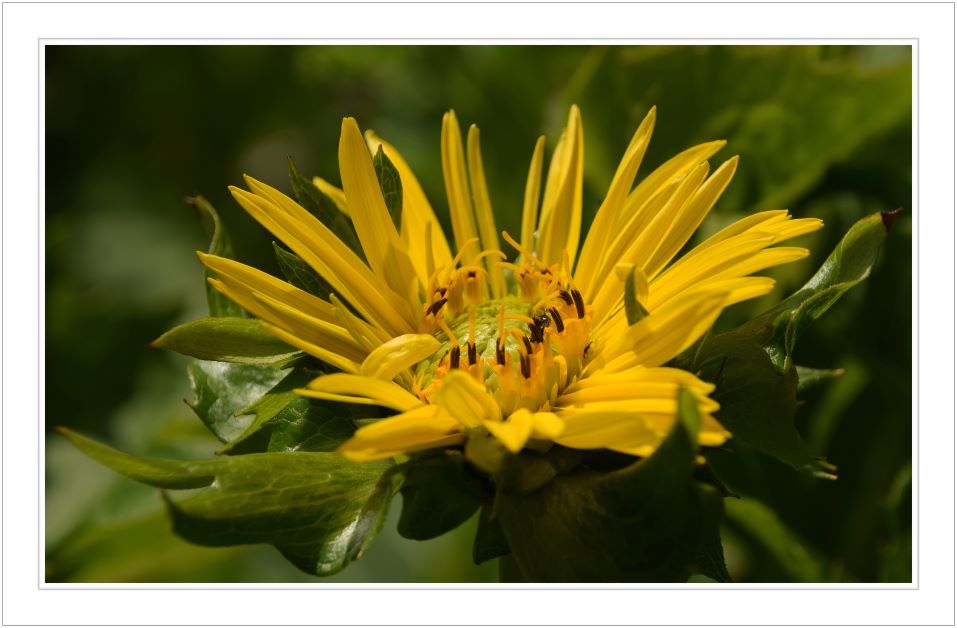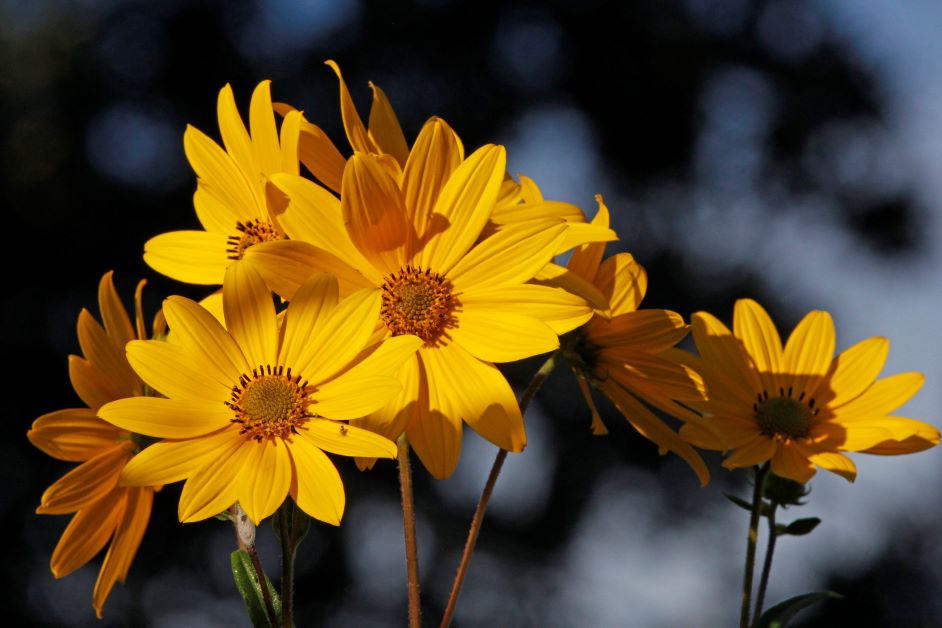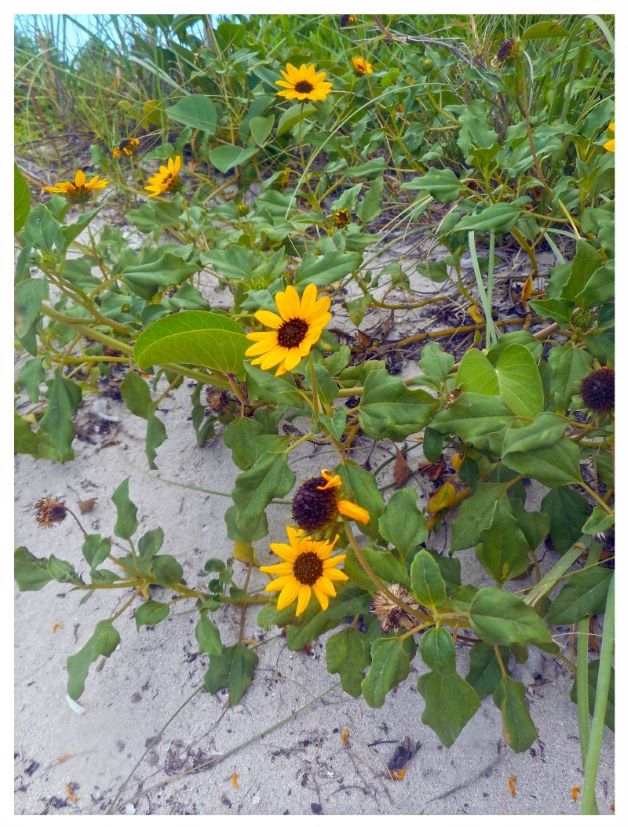Do Sunflowers Grow in Florida?
What Sunflowers Grow in Florida?
There are over 70 varieties of sunflowers in the world and 19 of them are native to Florida. Each variety has its own distinct features and serves different uses in your garden. Some sunflowers make a great groundcover while others are better suited as a food crop, for example.
Take a look through this list for help choosing which Florida native sunflower you’d like to plant in your landscape this season.
Florida Native Sunflowers
Swamp Sunflower (Helianthus angustifolius)

The swamp sunflower, or narrow-leaf sunflower, grows as far north as New York and as far west as Texas.
With its small head and branchy stem, this sunflower looks a lot like a daisy. It’s a clumping perennial that dies back if it gets cold enough during the winter.
The swamp sunflower grows in all of Florida and is a common sight on the roadside in North Florida and the panhandle. As you may have guessed, the swamp sunflower does best in wet, marshy conditions.
If you have a meadow or large space to fill, the swamp sunflower is a good choice. It also does great along ponds and lakes. Wherever you plant it, give swamp sunflower lots of room. It spreads quickly and will choke out other nearby plants.
One swamp sunflower plant can produce up to 16 heads. A meadow full of swamp sunflowers is sure to draw in thousands of bees, butterflies, moths, birds, and wasps.
East and West Coast Dune Sunflowers (Helianthus debilis subsp. debilis and Helianthus debilis subsp. vestitus)

The dune sunflower is a tough, drought-tolerant Florida native. Also known as the beach sunflower, the dune sunflower is a perennial found on the coast. There are 2 subspecies of dune sunflower: the east coast dune sunflower and the west coast dune sunflower. Both are very similar with the east coast subspecies growing more upright than the west coast.
If you’re not lucky enough to live on the coast, don’t worry – the dune sunflower is one of the best sunflowers to grow in Florida. This is an easy grower that will thrive inland as long as you’re in zone 9 or below. This self-seeding sunflower creeps along the ground and makes a wonderful Florida native ground cover. It spreads fast, so be sure to give it lots of room to roam and be ready to cut it back from time to time.
Unlike some other sunflowers, you can grow the beach sunflower from cuttings.
How to Grow Beach Sunflower from Cuttings:
- Remove the bottom few leaves from the stalk, making sure to keep some growth on the top.
- Bury the bottom of the stalk a few inches into a container of potting soil.
- Water it in, keep the soil moist, and in a spot that gets plenty of warmth and sunshine.
- When your sunflowers are hardy and established (in 2-3 months), transplant them to their permanent location.
Purpledisk Sunflower (Helianthus atrorubens)

Purpledisk sunflower is a perennial that grows via underground rhizomes. This sunflower isn’t a huge fan of extreme heat, so you’re more likely to find it in North Florida and the Panhandle. It tends to grow on the side of the road and in wooded areas.
Purpledisk sunflower grows to be 5 or 6 feet tall and dies back during winter. It also spreads with each passing year. If you have a sunny spot in your yard that doesn’t get much attention, consider adding purpledisk sunflower. It looks pretty, attracts pollinators, and needs little to no attention.
Cucumberleaf Sunflower (Helianthus debilis subsp. cucumerifolius)

The cucumberleaf sunflower, east coast dune sunflower, and west coast dune sunflower are all very similar to each other. In fact, some people call all 3 species “beach sunflower” and leave it at that. The cucumberleaf sunflower has slightly more triangular leaves that aren’t as shiny as the beach sunflower’s but to the untrained eye, they look the same. The cucumberleaf sunflower also grows a bit more upright that the dune sunflower.
The care instructions and growth habits for dune sunflower apply to the cucumberleaf sunflower.
Woodland Sunflower (Helianthus divaricatus)

The woodland sunflower grows in Canada and most of the United States (including North Florida). It stands 6 feet tall and has a 3-foot spread. Obviously, this species tends to grow in the woods but it also thrives in prairies, empty lots, and on the side of the road.
This rhizome-grown sunflower is aggressive. You’ll have to break up your woodland sunflower patch every 3 or 4 years to give it more room to ramble and keep it healthy. Plan ahead and only grow this species if you have the space.
Variableleaf Sunflower (Helianthus heterophyllus)

Also known as the wetland sunflower, variableleaf sunflower is a Panhandle perennial. This species is unique because of its stem. Most of the time, it’s leafless except during spring, at which point you’ll see some growth close to the bottom of the stem. These leaves grow tiny hairs that make them feel a little prickly.
The variableleaf usually grows to be 4 feet tall and grows in marshy areas. This isn’t a sunflower that many (if any) home gardeners grow, but it does bring some brightness to roadsides and wetlands. It’s also an important wildflower for pollinators and birds.
Hairy Sunflower (Helianthus hirsutus)

The hairy sunflower is known for, well…its hairiness. It has tiny hairs that grow all along the stem and leaves. This makes the flower feel bristly and for this reason, it’s also known as the rough sunflower.
In the United States, the hairy sunflower grows from Wisconsin down to Texas, from New York to Florida, and all the states in between. This species prefers dry areas and often grows in prairies, savannahs, and on the edges of the woods. The hairy sunflower is a wildflower and not really a species that people cultivate.
Small Woodland Sunflower (Helianthus microcephalus)

The small woodland sunflower grows in USDA zones 4 through 8. In Florida, you’ll find this wildflower in the Panhandle. The small woodland rhizome produces up to 8 flower heads per stem and usually grows in ditches, fields, and wooded areas.
This species grows to be 4 to 6 feet tall and spreads in a mass up to 3 feet wide. The small woodland sunflower can tolerate a wide range of soils, including clay, rocky, boggy, dry, slightly alkaline, and sandy. Plant this one if you need to fill up a meadow or to add some color to your butterfly garden.
Fewleaf Sunflower (Helianthus occidentalis)

Although the fewleaf sunflower is more common around the Great Lakes, it also grows in parts of the Florida Panhandle. It may go without saying but this species is called the fewleaf because it doesn’t have many leaves. The leaves it does have grow on the bottom of the stem. This one is also called the western sunflower.
Out of all the wild sunflowers on this list, the fewleaf is probably the least aggressive. It does need a little room, but it doesn’t spread as fast as some other species. It grows 2 to 5 feet tall and can produce more than one flowerhead per stem. The fewleaf sunflower isn’t picky about its soil, but it does prefer to be in a spot that’s sunny and dry.
Rayless Sunflower (Helianthus radula)

The rayless sunflower is the most unique-looking of all the native Florida sunflowers. Also known as the stiff sunflower, the rayless sunflower lacks the traditional yellow petals that come to mind when one thinks of a sunflower. That’s why it’s called the “rayless” sunflower. Instead of petals, the rayless sunflower has a singular flowerhead made up of dark disk florets.
Hardy to USDA zones 8A to 9B, the rayless sunflower calls the Panhandle, North Florida, and Central Florida it’s home. It also grows in South Carolina and Louisiana.
This species is great for attracting pollinators. Ditch your non-native milkweed and instead include the rayless sunflower in your next butterfly garden.
Resindot Sunflower (Helianthus resinosus)

The resindot sunflower is native to Florida, Georgia, Mississippi, Alabama, North Carolina, and South Carolina. In Florida, it grows wild in the Panhandle.
This attractive specimen grows to be 8 feet tall and can produce up to 5 flower heads per stem. The resindot is self-seeding and also grows via suckers. It’s incredibly easy to grow, so much so that it can be hard to keep it from overrunning your garden. It likes full sun to part shade and doesn’t really care about the soil it’s grown in.
Lakeside Sunflower (Helianthus carnosus)
The lakeside sunflower is endangered and rare. If you’re lucky enough to find one growing wild in Florida, you must be in the upper west side of the state. This species only grows in 6 counties: Duval, St. Johns, Clay, Flagler, Putnam, and Volusia.
If you want to add this one to your collection, check the FANN database – some specialty nurseries keep the lakeside sunflower in stock. You should know, though, that this species is finicky to keep alive if you don’t replicate its ideal growing conditions. The lakeside sunflower likes a moist environment and usually grows next to bodies of fresh water.
Most of the time, the lakeside sunflower looks like a clump of low-lying green foliage. During the summer, the flower emerges and grows to be about 3 feet tall. The bloom looks like your typical wild sunflower with a smallish head and yellow petals.
Florida Sunflower (Helianthus floridanus)
Contrary to its name, the Florida sunflower isn’t just a Florida native – it grows in most of the Southeastern U.S. In Florida, you’ll find it wild on the Northeast coast around Jacksonville.
This is an upright growing sunflower that can reach 7 feet tall and like a lot of the wild sunflowers on the list, also spreads via rhizomes. Whenever you see the word “rhizome” on this list, just think “needs lots of room.”
The Florida sunflower likes a moist environment so plant it in wetlands and next to bodies of water. It blooms in late summer and early fall, dies back during winter, and comes back in spring.
Paleleaf Woodland Sunflower (Helianthus strumosus)

The paleleaf woodland sunflower grows throughout the Eastern United States and Great Plains. In Florida, it’s mostly found to the North and in the Panhandle. It can be hard to tell this species apart from other wild sunflowers. The most obvious features of the paleleaf woodland sunflower is its smooth, hairless stem and a slight whitish coloration under its leaves. A lot of people say that this wildflower looks a lot like the Jerusalem artichoke.
This species produce up to 15 blooms per stem and gets to be 7-feet tall. It isn’t particular about its growing conditions; the paleleaf woodland sunflower will grow in the woods, in prairies, in ditches, on roadsides, and in clearings.
Florida Naturalized Sunflowers
The sunflowers below aren’t native to Florida. They’re naturalized, instead. This means that these species didn’t originate from Florida but are now so common that they grow on their own in the wild.
Common Sunflower (Helianthus annuus)

This giant sunflower is the poster child of summer. It’s an annual that can grow up to 12 feet tall and is the sunflower to grow if you’re looking to add an edible flower to your garden.
Although it’s not very finicky, you should add fertilizer or amend your sandy soil when adding the common sunflower to your Florida garden. Unlike the Florida natives on this list, the common sunflower does better with fertile soil.
Because the common sunflower gets so tall, you will have to stake it up to stop it from falling over under its own weight. It also falls over easily in the wind, which can be a problem during our daily summer thunderstorms.
Before the common sunflower reaches its full height, it is heliotropic. This means it turns to face the sun as it moves across the sky. I like to plant my sunflowers in a row so that this phenomenon is more obvious. It’s neat to track the flowers’ movements throughout the day.
SIlverleaf Sunflower (Helianthus argophyllus)

The silverleaf sunflower is best known for its soft, silvery foliage. Each 6-foot-tall stem can grow up to 5 flower heads made up of long yellow petals with a dark brown center. Songbirds go wild for silverleaf seeds and it’s also good for attracting butterflies.
This species is native to Texas but also grows in parts of Florida and North Carolina. Floridians have spotted wild silverleaf sunflower in Leon, Franklin, Columbia, and Volusia counties. Technically an annual, the silverleaf will self-seed in Florida. Plant a batch of silverleaf in full sun and in well-draining soil and you can expect waves of pretty sunflowers year after year.
Muck Sunflower (Helianthus simulans)

It may have an ugly name, but the muck sunflower is anything but. This pretty sunflower stands at a tall 8 feet and in 3-foot wide clumps. Muck sunflower also grows from a rhizome — it’s a vigorous spreader and needs room to stretch its legs.
Muck sunflower grows in moist soil, so use it to border your pond or to fill a swampy area. This species also does best in part shade. If you have land that you struggle with because it’s too boggy, add the muck sunflower and you’ll find yourself with a gorgeous mass of yellow, daisy-like sunflowers.
Jerusalem Artichoke (Helianthus tuberosus)

Also known as sunchoke, sunroot, and wild sunflower, Jerusalem artichoke is a perennial grown for its edible tuber. Contrary to its name, Jerusalem isn’t from Jerusalem and it’s not an artichoke. This plant is native to parts of North America and while artichokes and Jerusalem artichokes are distant relatives, they aren’t the same. Jerusalem artichoke tastes a bit like artichoke, though, so the name stuck.
Jerusalem artichoke is usually cooked the same way you would a potato. It’s also commonly used in soups. and can be sliced thin and eaten raw. One important thing to note — Jerusalem artichoke can make you very gassy and if you eat too much, it can cause stomach cramps, too.
To grow Jerusalem artichoke, bury the tubers about 5 inches deep and 18 inches apart in spring. Make sure to give it a lot of clearance as this plant can grow to be 10 feet tall. Cut your flowers down to 4 feet mid-summer and harvest in late fall or winter. If you can, let your Jerusalem artichoke experience a frost as many say this makes the tuber tastier.







